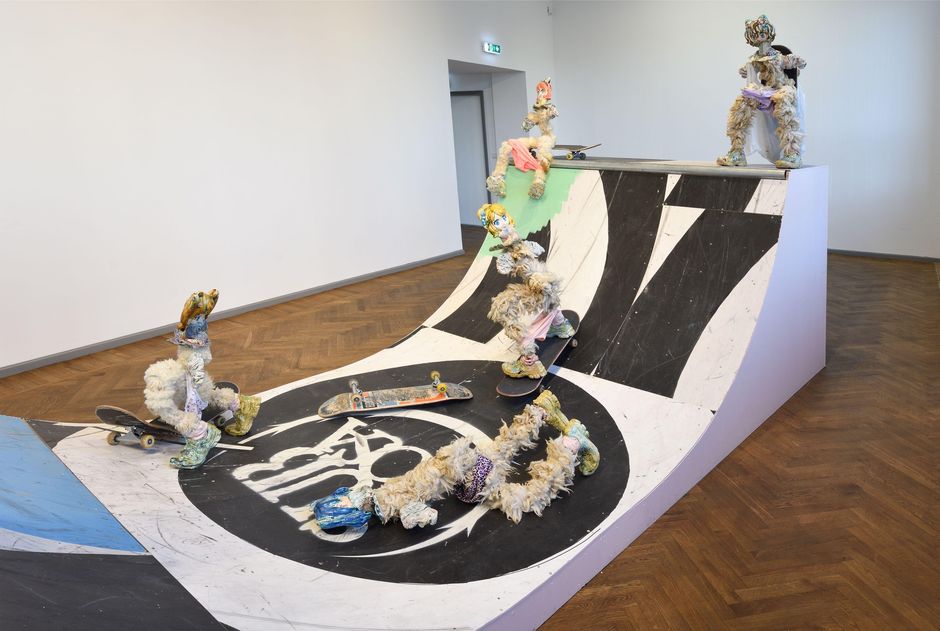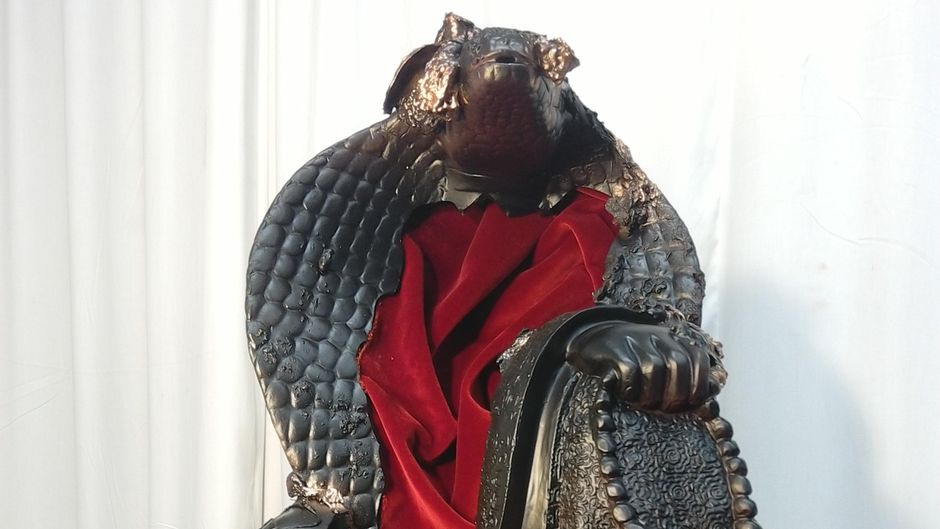Metamorphosis
HABIMA FUCHS, THOMAS HELBIG, RENAUD JEREZ, KRIS LEMSALU, MARY-AUDREY RAMIREZ
Duration: March 4 to May 27, 2017, Tues.-Sat., 12-5 pm
Curator: Zdenek Felix
Participating Institutions:
KAI 10 | ARTHENA FOUNDATION, Düsseldorf (March 4 to May 27, 2017)
Galerie Guido W. Baudach, Berlin (March 10 to April 15, 2017)
Galerie SVIT, Prag (June 5 to July 9, 2017)
The title Metamorphosis goes back to the mythological poem of the same name written in hexameter by the Roman author Ovid around 8 A.D. It tells stories of transformations of gods, heroes, humans, plants, and animals. For the leitmotiv of his book of fifteen poems, Ovid chose the idea of the essential transition from one condition into another, transforming Greek and Roman myths and legends into epic images. His poetic stories reveal portentous encounters between the divine and the mortal world, and their effects, which neither man nor nature, neither extraterrestrial nor earthly beings can elude. With subtle irony and not without humor, Ovid depicts the destiny of human existence as the consequence of reciprocal entanglement of all beings and gods, while creating a poetic and at the same time dramatic fiction of an all-encompassing cosmic order.
For the artists contributing to the exhibition Metamorphosis, the relationships between the divine and the worldly are of lesser importance. Rather, their works deal with the conversion of shapes, materials, bodies, ideas, and substances.
Czech artist Habima Fuchs (*1977in Ostrov, Czech Republic), who was born Astrid Sourkova, works in various media including sculpture, drawings, performances, and installations. She lives as a “cultural nomad” between the Czech Republic, Germany, France, Spain, and Italy. The range of the territory within which she moves is reflected in the breadth of the topics she addresses. She draws from myths and legends of diverse origins with primarily spiritual content. Animals like cats, lions, and tigers enter metamorphotic relationships with humans in Fuchs’ ceramic objects. In the cycle Daimonion, for instance, creatures appear with mixed body parts, some animal and some human, like the centaur in Greek mythology. Just as wild centaurs symbolize the power and sensuality of nature, the “demons” in Fuchs’ work suggest the spiritual powers which humans can draw from through direct and meditative contact with nature.
Thomas Helbig (*1967 in Rosenheim, Germany) is a painter, illustrator, and sculptor. He studied at the Akademie der Bildenden Künste (Academy of Fine Arts) in Munich and at Goldsmiths College in London. Indefinite entities appear in his paintings that transpire somewhere between real and abstract shapes, yet in reality represent autonomous emblems with strong symbolic expression. They emerge from the subconscious as vague appearances relating to the perceptible world. Early in his career as a painter, Thomas Helbig used the potential of the modern age to play with its vocabulary of form, while at the same time deconstructing it. In contrast, his collage sculptures of the past few years demonstrate a different kind of transformation of the source materials he uses. His repertoire is based on a fundus of discarded, thrown-out things, as well as kitschy plastic sculptures found in the decoration sections at department stores. Helbig mixes and connects these disparate elements into new forms, which are displayed as coded messages from an enigmatic present.
French artist Renaud Jerez, who lives between Berlin and Los Angeles (*1982 in Narbonne, France), has made a name for himself over the past five years as the author of odd installations and disturbing sculptures made of metal, wire, lead pipes, cables, and other industrial materials. Out of these recycled objects, he creates strange figures and robots that remind one of creatures from far-away galaxies in science fiction movies. Jerez’s figures are suggestive, so that it often appears as if a hint of decay is in the air, reminding one of mummified, biologically emptied human creatures, of witnesses of distant civilizations whose traces can only be found in graves and secret spaces. One ponders whether these androids and undead beings more likely refer to an apocalyptic future rather than pointing towards some corner of the world’s history. In any case, the materialized horrors of Jerez’s installations confront us with a dystopian model of a messed-up evolution, in which human creations become self-sufficient and transform into their own anti-world.
Estonian artist Kris Lemsalu (*1985 in Tallinn, Estonia) is a sculptor and ceramic artist, working with the media of installation and performance. After studying at the Estonian Art Academy in Tallinn, she continued her education at art academies in Copenhagen and Vienna. She gained attention for her work over the past few years with performances such as one at Frieze in New York in 2015, when she lay under a giant ceramic turtle shell for more than three hours, with only her naked feet, hands, and a bit of hair sticking out. This created a provocative contrast between the weight of the shell of the fictitious turtle, a visual metaphor of the metamorphosis from human to animal and vice versa. At the same time, this spectacular public performance could be read as a manifest of loneliness, isolation, and repression of the individual within today’s society, and especially in the business of art. In other works, Lemsalu addresses the metamorphoses of the body and its biological and energetic processes, in which she makes her direct mental and physical approach the main criterion of her work.
Artist Mary-Audrey Ramirez, who originates from Luxembourg and lives in Germany (*1990 in Luxemburg) studied multi-media with Thomas Zipp at the Universität der Bildenden Künste (University of Fine Arts) in Berlin. The focus of her interest lies in sculptural work and installations. She has developed a special technique for her two-dimensional images: with some help from a sewing machine, she creates linear shapes that start off spontaneously and free, and then during the sewing process they are transformed into legible figurations. They depict mysterious scenes filled with humans and animals that flow in and out of one another, are interconnected, and then change their form in the next moment. With black and white as well as colored threads, Ramirez develops an ominous world ruled by fear, violence, and aggression. The humans appear to be subservient to the animals, or they fight back. These dark scenes are in part playfully broken up in an ironic manner and lead into the realm of the fantastical. The three-dimensional works of the Luxembourg artist, too, present her disposition toward irony, such as the sculpture of an anteater, which is touching his long tongue to the derriere of a performer doing acrobatics below him, a perverse image of the metamorphosis of the traumatic ideas and wishes of both sexes.





